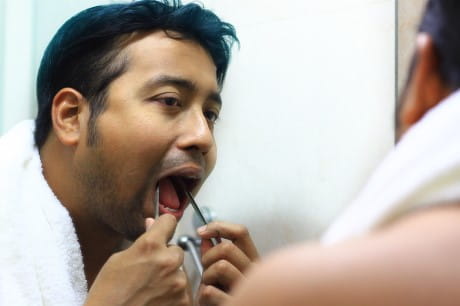What’s your tongue trying to tell you?
Your tongue doesn’t just help you taste. It can also give you input about your health.
Got something on the tip of your tongue? What about on top? Maybe even on the side? Like most people, you probably don’t pay much attention to your tongue. But believe it or not, your tongue is a great indicator of your overall health.
“The size, shape and color of your tongue can indicate medical conditions like hyperthyroidism, thrush infections and vitamin deficiencies,” explains Seth Linker, MD, an otolaryngologist at Geisinger.
Here are some signs your tongue may be giving you and what they mean.
White, lumpy coating
A thick, white coating on your tongue could be a sign of an oral yeast infection known as thrush.
“Your tongue is home to many different organisms, including bacteria and yeasts,” said Dr. Linker. “If the Ph balance is disrupted by something like antibiotics, it can cause thrush.”
Besides thrush, white spots on your tongue could also be caused by:
- Irritation from your teeth, smoking, braces or dentures
- Dehydration
- Excessive alcohol use
- Mouth breathing
- Infection or illness
Black or brown fuzz
The cells on your tongue are constantly growing. For some people, these cells grow faster than your tongue can shed them. As these cells grow, they can resemble fuzz or hairs. And as bacteria grow on them, they can turn brown or black.
A black or brown tongue, known as “hairy tongue,” isn’t harmful. But it may be unsightly and cause bad breath. Hairy tongue is commonly caused by:
- Smoking
- Drinking black coffee or tea
- Poor dental hygiene
Another possible cause? Using medicine that contains bismuth. “Using antidiarrheal or anti-nausea medications with bismuth may turn your tongue black,” says. Dr. Linker.
Not to worry, though. That discoloration isn’t harmful and will go away after you brush your teeth.
If you suspect you have hairy tongue, talk to your dentist. They may recommend using a tongue scraper or brushing your teeth differently.
Wrinkles, ridges and valleys
As your tongue ages along with the rest of your body, it may show cracks and ridges. While it may look serious, these ridges are harmless.
Ridges in your tongue can also be caused by other conditions, like:
- Geographic tongue. Smooth, red patches that resemble a map. Can be caused by vitamin deficiencies, allergies or medical conditions.
- Scalloped tongue. Indentations on the side of tongue. Can be caused by stress or an over-active thyroid.
Strawberry red
If you have a glossy, bright red tongue, it could mean you have a vitamin deficiency. The cells on your tongue require nutrients like vitamin B12 and iron to mature. If these cells don’t mature, they can die off, causing your tongue to appear smooth.
If your tongue is bright red, ask your doctor whether you should take supplements or change your diet to get more nutrients.
See something? Say something.
Most tongue changes are harmless and temporary. If you notice anything abnormal about your tongue, start by talking to your healthcare provider. They can help identify the cause behind your tongue changes. And if necessary, help you start treatment.
Next steps:
Learn about otolaryngology care at Geisinger
What color is your phlegm?
Meet Seth Linker, MD





